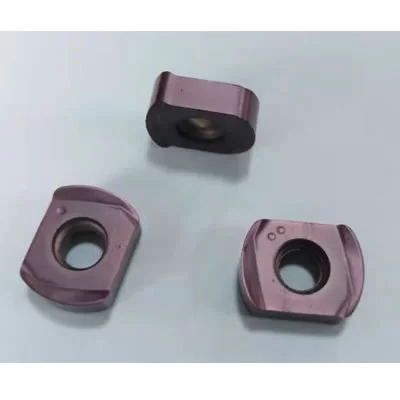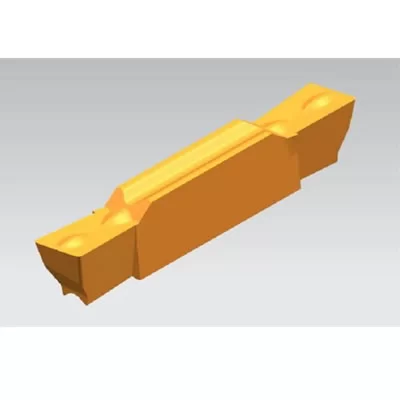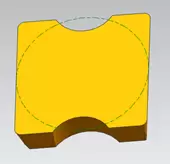The Choice Of Lathe Indexable Blade (CNC Blade)
After getting the workpiece drawing, first select the indexable blade with proper shape according to the requirements of the drawing. Generally, the lathe is mainly used to turn the outer circle and inner hole, cut and cut the groove, and turn the thread. The selection of blade is determined according to the specific conditions of processing technology. Generally, the blades with high versatility and more cutting edges on the same blade should be selected. Select larger size for rough turning and smaller size for fine and semi fine turning. According to the technological requirements, we determine the required blade shape, cutting edge length, tip arc, blade thickness, blade back angle and blade accuracy.
一. Select the blade shape
1. The blade of the outer circleS-shape: four cutting edges, with short cutting edge (refer to the same internal cutting circle diameter), high strength of tool tip, mainly used for 75 ° and 45 ° turning tools, and used for processing through-hole in internal hole tools.
T-shape: three cutting edges, long cutting edge and low strength of the tip. The blade with the auxiliary deflection angle is often used on the general lathe to improve the strength of the tip. Mainly used for 90 ° turning tools. The inner hole turning tool is mainly used for machining blind holes and step holes.
C shape: there are two kinds of sharp angles. The strength of the two tips of the 100 ° sharp angle is high, generally made into a 75 ° turning tool, which is used to rough turn the outer circle and the end face. The strength of the two edges of the 80 ° sharp angle is high, which can be used to process the end face or the cylindrical surface without changing the tool. The inner hole turning tool is generally used to process the step hole.
R-shape: round edge, used for machining special arc surface, high utilization rate of blade, but large radial force.
W shape: three cutting edges and short, 80 ° sharp angle, high strength, mainly used for machining cylindrical surface and step surface on general lathe.
D-shape: the two cutting edges are long, the cutting edge angle is 55 ° and the strength of the cutting edge is low, which is mainly used for profiling processing. When making a 93 ° turning tool, the cutting angle shall not be greater than 27 ° - 30 °; when making a 62.5 ° turning tool, the cutting angle shall not be greater than 57 ° - 60 °, which can be used for step hole and shallow root cleaning when processing the inner hole.
V shape: two cutting edges and long, 35 ° sharp angle, low strength, used for profiling. When making 93 ° turning tool, the cutting angle shall not be greater than 50 °; when making 72.5 ° turning tool, the cutting angle shall not be greater than 70 °; when making 107.5 ° turning tool, the cutting angle shall not be greater than 35 °.
2. Cutting and grooving blades:
1) cutting blade:
In CNC lathe, cutting blade is usually used to press chip breaking groove shape directly. It can make chips shrink and deform laterally, cut easily and reliably. In addition, it has large side deflection angle and back angle, less cutting heat, long service life and higher price.
2) grooving blade: generally, the cutting blade is used to cut the deep groove, and the forming blade is used to cut the shallow groove, such as the following: vertical grooving blade, flat grooving blade, strip grooving blade, step cleaning arc root groove blade. These blades have high groove width accuracy.
3. Thread blade: L-shaped blade is commonly used, which can be reground and cheap, but it can't cut the top of the tooth. The thread with high cutting accuracy needs to use the blade with good profile grinding. Because the internal and external thread have different profile sizes, they are divided into internal and external thread blades. Their pitch is fixed and can be cut out of the crown. As a clamping method, it can be divided into two kinds: one is a blade without hole, which is clamped by pressing up. When processing materials with high plasticity, this blade also needs to add a baffle plate; the other is a blade with a clamping hole and a chip breaking groove, which is clamped by a plum screw with a pressure hole.
二. Cutting edge length
Cutting edge length: it shall be selected according to the back draft. Generally, the length of the cutting edge of the through groove blade shall be ≥ 1.5 times of the back draft, and the length of the cutting edge of the closed groove blade shall be ≥ 2 times of the back draft.
三. tip arc
Tip arc: as long as the rigidity is allowed for rough turning, the larger tip arc radius can be used as far as possible, while the smaller arc radius is generally used for fine turning. However, when the rigidity is allowed, it should also be selected from the larger value, and the commonly used pressed forming circle radius is 0.4; 0.8; 1.2; 2.4, etc.
四. blade thickness
Blade thickness: the selection principle is to make the blade have enough strength to bear the cutting force, which is usually selected according to the back feed and the feed. For example, some ceramic blades need to choose thicker blades.
五. back angle of blade
Blade back angle: commonly used:
0 ° code n;
5 ° code B;
7 ° code C;
11 ° code P.
0 ° back angle is generally used for rough and semi finish turning, 5 °; 7 °; 11 °, generally used for semi finish, finish turning, profiling and machining inner holes.
六. blade accuracy
Blade precision: there are 16 kinds of precision specified by the state for indexable blades, among which 6 kinds are suitable for turning tools, the code is h, e, G, m, N, u, h is the highest, u is the lowest, u is used for rough and semi finish machining of general lathe, M is used for CNC lathe or m is used for CNC lathe, and G is used for higher level.
After the above steps, we have basically determined what kind of blade should be used. In the next step, we need to further check the electronic samples of blade manufacturers, and finally determine the type of blade to be used according to the materials and precision to be processed.

















